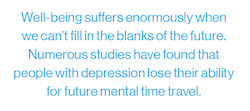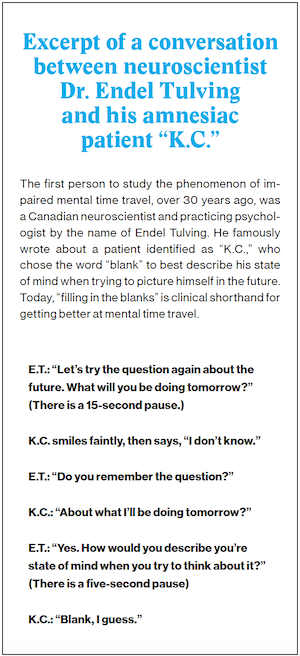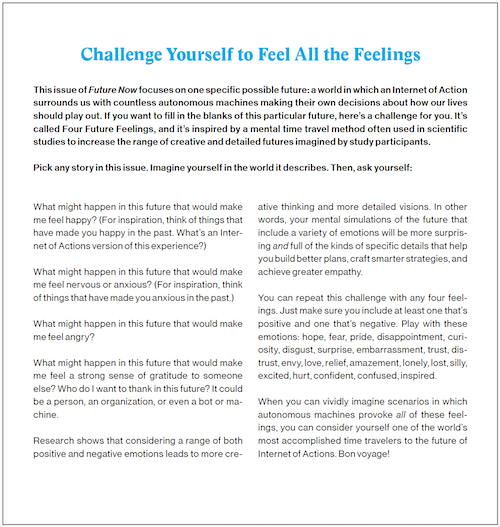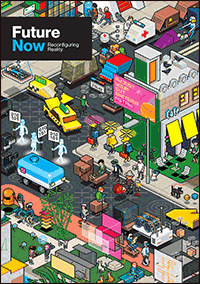Future Now
The IFTF Blog
Fill in the Blanks
Train your brain to see more clearly what isn’t there (yet)
 An intervention designed to restore normal cognitive function in people with amnesia, brain injury, severe depression, and autism has been shown to help anyone get extraordinarily good at seeing the future.
An intervention designed to restore normal cognitive function in people with amnesia, brain injury, severe depression, and autism has been shown to help anyone get extraordinarily good at seeing the future.
When was the last time you traveled to the future? If you’re like most people, the answer is: just a few minutes ago. That’s because the average person travels to the future a whopping 59 times a day.
These journeys take place not in a time machine, of course, but in our own minds. We visualize what we’ll be doing a few hours from now so we can pick out something appropriate to wear. We practice important conversations in our heads so we can be better prepared for how others might respond. We imagine how proud we’ll feel when we finally accomplish a long-term goal and we use that “pre-feeling” to motivate ourselves. We speculate about how our lives would become different, for better and for worse, to help us make important decisions. We idly daydream about adventures we hope to have some far away day to give ourselves an emotional lift.
Whether the future in question is five hours from now or five years from now, research shows that we mentally project ourselves forward in time roughly once every 15 minutes that we’re awake. Not all the trips are pleasant, of course. We may torture ourselves (or perhaps, as we see it, steel ourselves) by vividly envisioning the worst things that could plausibly lie ahead: being the victim of a crime, our plane crashing, or a loved one dying. But statistics say we visit positive futures roughly three times as often as we visit negative ones.
Scientists call this “mental time travel.” It’s not just thinking about the future. It’s simulating and immersing ourselves in it, like a 3D movie or virtual reality in our mind. There’s a sense of being present in the future, of being able to see and feel it as if it were already happening. Most of us do this so often, we take our time travel ability for granted. But not everyone can make the trip.
Stuck in the Present
For some people—described as having “low” or “impaired mental time travel ability”—their minds draw a total blank when they try to picture themselves in the future. It’s like staring into an empty crystal ball. No mental movie plays. No mental virtual reality fires up.
It’s not that these people can’t think about the future at all. They can make general predictions just fine: tomorrow it might rain, a new Star Wars will probably come out next winter, the United States might elect its first woman president someday. But when they try to envision themselves in any of these possible futures—What would it physically feel like to stand in the rain tomorrow? Who would I invite to go to the Star Wars movie with me? How would I personally react to breaking news of the first woman president, and where might I be when I heard the news?—then the future becomes fuzzy. Details are missing. Emotions don’t arise.
When they try to “look around” these futures, instead of seeing detailed, three-dimensional scenes, they see nothing. And this has important consequences for their ability to make plans, adapt to change, connect with others, and even simply motivate themselves to get out of bed in the morning.
Trouble with Time Travel
Who, exactly, has such difficulty imagining their personal futures? For starters, anyone who has trouble revisiting their past likely can’t visit theirfuture either. This includes patients with amnesia, a concussion, or brain injury.
 That’s because, as many functional MRI studies have shown, a common “core network” of brain regions are involved in mentally simulating both the things we’ve already done and the things we might do someday. This core network includes the hippocampus, which is responsible for constructing 3D representations of the world around us, and the medial prefrontal cortex, which monitors our environment for changes that may require us to update our goals or adapt our strategies.
That’s because, as many functional MRI studies have shown, a common “core network” of brain regions are involved in mentally simulating both the things we’ve already done and the things we might do someday. This core network includes the hippocampus, which is responsible for constructing 3D representations of the world around us, and the medial prefrontal cortex, which monitors our environment for changes that may require us to update our goals or adapt our strategies.
When the common core network is compromised by injury or illness, our simulation circuitry fails. We can remember or anticipate general facts, but not stories of our own lives. That’s why, although we usually think of amnesia as erasing someone’s past, it actually erases their future as well. Alzheimer’s patients, who likewise often lose access to so many of their life memories, also have great difficulty describing in any detail what they might do in the future.
 Why does this matter? Our daily functioning depends on our ability to imagine our futures. Consider patients with advanced multiple sclerosis (MS), who often experience inflammation and scarring in regions of the brain associated with mental time travel. These patients can have trouble setting and following through on everyday goals. An MS patient might not bring her wallet to the store, for example, because she wasn’t able to mentally “pre-travel” there and realize she would need money to pay at the checkout line. Or these patients find themselves chronically lonely and bored, facing unusually empty stretches of time. That’s because they haven’t been able to imagine what they might want to do, and therefore don’t make plans for themselves or with others.
Why does this matter? Our daily functioning depends on our ability to imagine our futures. Consider patients with advanced multiple sclerosis (MS), who often experience inflammation and scarring in regions of the brain associated with mental time travel. These patients can have trouble setting and following through on everyday goals. An MS patient might not bring her wallet to the store, for example, because she wasn’t able to mentally “pre-travel” there and realize she would need money to pay at the checkout line. Or these patients find themselves chronically lonely and bored, facing unusually empty stretches of time. That’s because they haven’t been able to imagine what they might want to do, and therefore don’t make plans for themselves or with others.
Well-being suffers enormously when we can’t fill in the blanks of the future. Numerous studies have found that people with depression lose their ability for future mental time travel. Indeed, parts of the common core network responsible for mental time travel actually lose gray matter and shrink over time in cases of severe depression. Some scientists speculate that time travel impairment may indeed be one of the underlying reasons why depression feels so debilitating. When we can’t imagine our personal futures in vivid detail, the motivation and reward centers of the brain refuse to fire up. The “feel good” dopamine chemicals that flood our brains whenever we anticipate the possibility of something good happening, the same chemicals that give us energy and willpower to tackle tough tasks and pursue our goals, simply don’t activate. That’s because the brain literally can’t anticipate something good happening—it sees “blanks” instead of positive outcomes. So the brain says, “Don’t bother.” No wonder we have a hard time getting out of bed when we’re depressed. We can’t imagine—at least not in an immersive, detailed way—anything worth getting out of bed for.
Research has shown that this kind of time travel impairment is also experienced by people suffering from post-traumatic stress disorder, people with autism, and people whose basic survival resources are insecure.
Fixing the Problem
What can be done to help individuals with impaired time travel ability? Researchers have devised and tested a simple intervention to correct problems with mental time travel. It’s called “specificity training,” and multiple studies have shown it to be effective in restoring future imagination.
Here’s how it works: instead of thinking about the future, patients first practice remembering their past or imagining other hypothetical scenarios as vividly as possible. They answer a series of questions designed to draw out highly specific details. Here are sample prompts from actual studies of specificity training:
Think of a particular time in the past you had a delicious meal. What time of day or night was it? What, exactly did you eat? Describe what it looked like and tasted like in vivid detail. What did the room you were eating in look like? Who else was there? What emotions did you feel? What did the other person or people with you feel, if you can speculate or remember?
Picture yourself going to a circus. What time of day or night is it? What is the weather like? What might you see as you approach the circus? What colors are most prominent? What sounds do you hear around you? Who talks to you as you enter the circus? What do they say? What do you say to them? What do you smell? What emotions do you feel?
These specificity prompts are designed to encourage patients to imagine all five senses—sight, hearing, touch, taste, and smell. They encourage a greater awareness of emotions to heighten immersion in the imagined moment. And they turn the patients’ awareness to possible social interactions, to help increase the social simulation skills required to vividly imagine what others feel or might do.
 The more specific details the patient includes in their written or verbal description, the higher score they receive. Patients work, over several weeks, to earn higher and higher scores. And it really helps: Studies show that over time, patients not only get better at filling out their past memories or hypothetical scenarios with more vivid details, but their ability to see themselves in the future gets better as well. As one patient put it: “It’s easier to imagine things, to project myself. Before, it was like I could only see flashes. Now, it’s more like watching a film.” As another describes it: “Now I have the feeling that I’m living the thing, I’m in it. The future events, I can feel them.”
The more specific details the patient includes in their written or verbal description, the higher score they receive. Patients work, over several weeks, to earn higher and higher scores. And it really helps: Studies show that over time, patients not only get better at filling out their past memories or hypothetical scenarios with more vivid details, but their ability to see themselves in the future gets better as well. As one patient put it: “It’s easier to imagine things, to project myself. Before, it was like I could only see flashes. Now, it’s more like watching a film.” As another describes it: “Now I have the feeling that I’m living the thing, I’m in it. The future events, I can feel them.”
As their mental time travel scores go up, these patients get better at life planning, anticipating others’ reactions, and motivating themselves to achieve and follow through on their goals. And this isn’t just a placebo effect. Brain scans of patients who have completed specificity training show increased brain activations and connectivity in the common core network that enables mental time travel.
Anyone Can Get Better at Filling in the Blanks—Even if You’re Already Good At It
If specificity training can help someone with a brain impairment get back to normal cognitive function, could the same technique help someone with ordinary mental time travel ability become exceptional at it? Yes! The research suggests that it does.
In studies, ordinary people taken through a series of specificity training exercises improved their imagination and simulation skills in several important ways. Their imagined futures became more vivid, more detailed, and the details themselves were rated as more interesting and creative. Afterward, when asked to come up with strategies for solving difficult problems, the participants came up with more detailed plans, and their strategies were rated by experts as more likely to be effective. Empathy scores went up when participants were asked to simulate what might be going on in someone else’s mind. And when thinking about personal futures they hoped would come to pass, self-motivation and willpower increased, as individuals were more likely to keep striving toward a future they could envision more vividly.
In short: specificity training not only helps restore normal mental time travel ability, it can also be used to supercharge that ability to help anyone develop a more vivid imagination, become a more creative and effective problem solver, improve our powers of empathy, and increase our motivation to make the futures we want.
Get Specific Right Now
Now that you know how specificity training works and why it helps, you can use it anytime you want to improve your ability to fill in the blanks of the future. (Or, you can use it with a group to improve your collective creativity and foresight!)
First: before you try to travel to a future, go to your past. Power up the “common core” network of your brain by simulating in great detail any experience you’ve had in your life. Pick a moment in the near or far past, and visualize it in your mind as clearly as you can. Tap into all five senses: try to recall as clearly as you can what you saw, heard, smelled, tasted, and physically felt in this moment. (Smell and taste may not be relevant to every memory, but make sure you really draw out the details of sight, sound, and physical sensation.) Spend at least three minutes immersing yourself in this memory and recording as many details as you can. You can write down the details, or take turns describing them out loud to someone else.
Pro tip: you can visit any memory at all. Just be sure to pick different memories each time you use this technique. It gets easier to simulate memories the more often you actively remember them, so this technique becomes less effective if you repeat the same memories.
Once your mental time travel pathways are primed, turn your attention to the future. As you try to imagine yourself having an experience in a possible future, start with questions a journalist would ask: What is happening? When is it happening and what time of day, exactly? Where are you—what do you see and hear in your environment? Who is there with you? How do you feel? Describe it in the present tense, as if it is happening to you right now. “I am inside a self-driving car, in what used to be called ‘the driver’s seat.’ The seats are black leather. The windows are up and the air-conditioning is on. The car still has a new car smell, because autonomous vehicles have only been widely available for public use for a few months now. I’m eating an egg salad sandwich—why not? My hands are free.” Keep going and fill out as many details as you can. Don’t worry about telling a story—the “plot” isn’t as important as setting a scene and recording as many details as you can. And don’t pressure yourself into having any amazing insights about the future when you practice this technique. Insight comes later. Think of specificity training as a crucial core-strengthening exercise to give you the mental muscles for creative foresight.

 FUTURE NOW—Reconfiguring Reality
FUTURE NOW—Reconfiguring Reality
This third volume of Future Now, IFTF's print magazine powered by our Future 50 Partnership, is a maker's guide to the Internet of Actions. Use this issue with its companion map and card game to anticipate possibilities, create opportunities, ward off challenges, and begin acting to reconfigure reality today.
About IFTF's Future 50 Partnership
Every successful strategy begins with an insight about the future and every organization needs the capacity to anticipate the future. The Future 50 is a side-by-side relationship with Institute for the Future: a partnership focused on strategic foresight on a ten-year time horizon. With 50 years of futures research in society, technology, health, the economy, and the environment, we have the perspectives, signals, and tools to make sense of the emerging future.
For More Information
For more information on IFTF's Future 50 Partnership and Tech Futures Lab, contact:
Sean Ness | [email protected] | 650.233.9517



